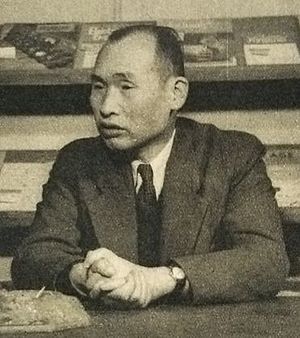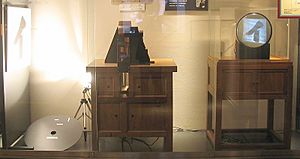Kenjiro Takayanagi facts for kids
Quick facts for kids
Kenjirō Takayanagi
|
|
|---|---|
| 高柳 健次郎 | |

Kenjirō Takayanagi in 1953
|
|
| Born | January 20, 1899 |
| Died | July 23, 1990 (aged 91) Yokosuka, Kanagawa, Japan
|
| Nationality | Japanese |
| Engineering career | |
| Discipline | Electrical engineering |
| Significant advance | Development of television |
Kenjiro Takayanagi (高柳 健次郎, Takayanagi Kenjirō, January 20, 1899 in Hamamatsu, Shizuoka – July 23, 1990 in Yokosuka) was a brilliant Japanese engineer. He was a true pioneer in creating what we know today as television. Even though he isn't as famous in Western countries, he actually built the world's first all-electronic television receiver. Because of his amazing work, many people call him "the father of television."
Contents
Building the First Electronic TV
In 1925, Takayanagi started researching television. He had read about this new technology in a French magazine and was very interested.
Early TV Experiments
He developed a system similar to one created by John Logie Baird. This system used a special spinning disk called a Nipkow disk to scan an image. It would then turn the image into electrical signals.
But Takayanagi did something very important and different from Baird. He used a cathode ray tube to show the picture. This tube is like the screen of an old TV. By using it, he created the first "all-electronic" television set. This meant it didn't need any moving parts to display the image.
On December 25, 1926, Takayanagi successfully showed his new system. This happened at Hamamatsu Industrial High School, where he was a teacher. The school is now part of Shizuoka University. The very first picture he sent was of the Japanese katakana character ![]() . This image was made up of 40 scan lines.
. This image was made up of 40 scan lines.
This amazing achievement happened several months before Philo T. Farnsworth showed his own electronic system. Farnsworth's system, demonstrated in San Francisco in September 1927, also did not need a Nipkow disk. You can learn more about this in the History of television.
Later Work and Legacy
In the years that followed, Takayanagi continued to be a key figure in television development. He worked at NHK (the Japan Broadcasting Corporation). Later, he joined JVC (Victor Company of Japan) and eventually became its vice president.
He also helped develop color television and video tape recorders. These inventions changed how people watched and recorded TV shows. Kenjiro Takayanagi passed away in 1990 at the age of 91.
Awards and Recognition
Kenjiro Takayanagi received many important awards for his contributions:
- Medal of Honor with Purple Ribbon - April 29, 1955
- Person of Cultural Merit - November 3, 1980
- Order of Culture - November 3, 1981
- Grand Cordon of the Order of the Sacred Treasure - April 29, 1989 (He received a lower class of this award in 1974)
- His work on developing television was named an IEEE Milestone in 2009.


